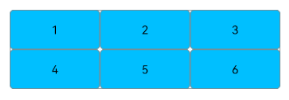TableLayout使用表格的方式划分子组件。图1 表格布局示意图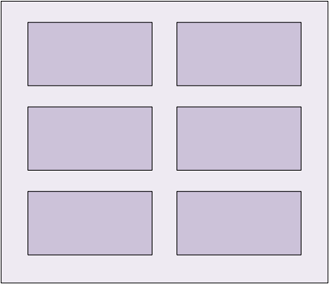
支持的XML属性
TableLayout的共有XML属性继承自:Component
TableLayout的自有XML属性见下表:

TableLayout的创建
- 在XML中创建TableLayout,示例代码如下:
<?xml version="1.0" encoding="utf-8"?>
<TableLayout
xmlns:ohos="http://schemas.huawei.com/res/ohos"
ohos:height="match_parent"
ohos:width="match_parent"
ohos:background_element="#87CEEB"
ohos:padding="8vp">
</TableLayout>添加子组件
- 在graphic文件夹下创建Text的背景table_text_bg_element.xml,示例代码如下:
<?xml version="1.0" encoding="utf-8"?>
<shape xmlns:ohos="http://schemas.huawei.com/res/ohos"
ohos:shape="rectangle">
<corners
ohos:radius="5vp"/>
<stroke
ohos:width="1vp"
ohos:color="gray"/>
<solid
ohos:color="#00BFFF"/>
</shape>在TableLayout布局中添加子组件。
<?xml version="1.0" encoding="utf-8"?>
<TableLayout
xmlns:ohos="http://schemas.huawei.com/res/ohos"
ohos:height="match_parent"
ohos:width="match_parent"
ohos:background_element="#87CEEB"
ohos:padding="8vp">
<Text
ohos:height="60vp"
ohos:width="60vp"
ohos:background_element="$graphic:table_text_bg_element"
ohos:margin="8vp"
ohos:text="1"
ohos:text_alignment="center"
ohos:text_size="20fp"/>
<Text
ohos:height="60vp"
ohos:width="60vp"
ohos:background_element="$graphic:table_text_bg_element"
ohos:margin="8vp"
ohos:text="2"
ohos:text_alignment="center"
ohos:text_size="20fp"/>
<Text
ohos:height="60vp"
ohos:width="60vp"
ohos:background_element="$graphic:table_text_bg_element"
ohos:margin="8vp"
ohos:text="3"
ohos:text_alignment="center"
ohos:text_size="20fp"/>
<Text
ohos:height="60vp"
ohos:width="60vp"
ohos:background_element="$graphic:table_text_bg_element"
ohos:margin="8vp"
ohos:text="4"
ohos:text_alignment="center"
ohos:text_size="20fp"/>
</TableLayout>- 图2 TableLayout默认一列多行
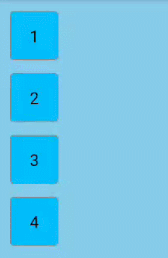
设置行列数
<TableLayout
...
ohos:row_count="2"
ohos:column_count="2">图3 设置TableLayout的行为2,列为2效果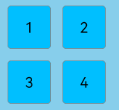
设置布局排列方向
在XML中设置布局排列方向,以“vertical”为例:
<TableLayout
...
ohos:orientation="vertical">
...
</TableLayout>图4 设置布局排列方向为“vertical”的效果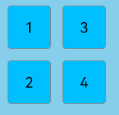
设置对齐方式
TableLayout提供两种对齐方式,边距对齐“align_contents”、边界对齐“align_edges”,默认为边距对齐“align_contents”。
- 边距对齐方式代码如下:
<?xml version="1.0" encoding="utf-8"?>
<TableLayout
xmlns:ohos="http://schemas.huawei.com/res/ohos"
ohos:height="match_content"
ohos:width="match_content"
ohos:alignment_type="align_contents"
ohos:background_element="$graphic:layout_borderline"
ohos:column_count="3"
ohos:padding="8vp">
<Text
ohos:height="48vp"
ohos:width="48vp"
ohos:background_element="$graphic:table_text_bg_element"
ohos:margin="8vp"
ohos:padding="8vp"
ohos:text="1"
ohos:text_alignment="center"
ohos:text_size="14fp"/>
<Text
ohos:height="48vp"
ohos:width="48vp"
ohos:background_element="$graphic:table_text_bg_element"
ohos:margin="16vp"
ohos:padding="8vp"
ohos:text="2"
ohos:text_alignment="center"
ohos:text_size="14fp"/>
<Text
ohos:height="48vp"
ohos:width="48vp"
ohos:background_element="$graphic:table_text_bg_element"
ohos:margin="32vp"
ohos:padding="8vp"
ohos:text="3"
ohos:text_alignment="center"
ohos:text_size="14fp"/>
<Text
ohos:height="48vp"
ohos:width="48vp"
ohos:background_element="$graphic:table_text_bg_element"
ohos:margin="32vp"
ohos:padding="8vp"
ohos:text="4"
ohos:text_alignment="center"
ohos:text_size="14fp"/>
<Text
ohos:height="48vp"
ohos:width="48vp"
ohos:background_element="$graphic:table_text_bg_element"
ohos:margin="16vp"
ohos:padding="8vp"
ohos:text="5"
ohos:text_alignment="center"
ohos:text_size="14fp"/>
<Text
ohos:height="48vp"
ohos:width="48vp"
ohos:background_element="$graphic:table_text_bg_element"
ohos:margin="8vp"
ohos:padding="8vp"
ohos:text="6"
ohos:text_alignment="center"
ohos:text_size="14fp"/>
</TableLayout>- 图5 边距对齐效果
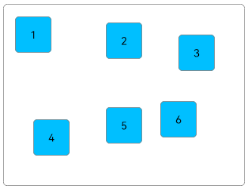
- 边界对齐方式将TableLayout的对齐方式修改为边界对齐。
<TableLayout
...
ohos:alignment_type="align_edges">
...
</TableLayout>- 图6 边界对齐效果
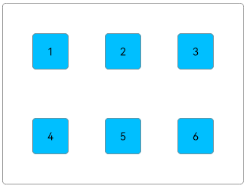
引用graphic文件夹下的背景资源文件为layout_borderline.xml,示例代码如下:
<?xml version="1.0" encoding="utf-8"?>
<shape xmlns:ohos="http://schemas.huawei.com/res/ohos"
ohos:shape="rectangle">
<corners
ohos:radius="5vp"/>
<stroke
ohos:width="1vp"
ohos:color="gray"/>
</shape>设置子组件的行列属性
实现合并单元格的效果
TableLayout合并单元格的效果可以通过设置子组件的行列属性来实现。图7 设置子组件的行列属性均为2的效果展示
在XML中创建TableLayout,并添加子组件,代码如下
<?xml version="1.0" encoding="utf-8"?>
<TableLayout
xmlns:ohos="http://schemas.huawei.com/res/ohos"
ohos:height="match_content"
ohos:width="match_content"
ohos:alignment_type="align_edges"
ohos:background_element="$graphic:layout_borderline"
ohos:column_count="3"
ohos:padding="8vp"
ohos:row_count="3">
<Text
ohos:id="$+id:text_one"
ohos:height="48vp"
ohos:width="48vp"
ohos:background_element="$graphic:table_text_bg_element"
ohos:margin="16vp"
ohos:padding="8vp"
ohos:text="1"
ohos:text_alignment="center"
ohos:text_size="14fp"/>
<Text
ohos:height="48vp"
ohos:width="48vp"
ohos:background_element="$graphic:table_text_bg_element"
ohos:margin="16vp"
ohos:padding="8vp"
ohos:text="2"
ohos:text_alignment="center"
ohos:text_size="14fp"/>
<Text
ohos:height="48vp"
ohos:width="48vp"
ohos:background_element="$graphic:table_text_bg_element"
ohos:margin="16vp"
ohos:padding="8vp"
ohos:text="3"
ohos:text_alignment="center"
ohos:text_size="14fp"/>
<Text
ohos:height="48vp"
ohos:width="48vp"
ohos:background_element="$graphic:table_text_bg_element"
ohos:margin="16vp"
ohos:padding="8vp"
ohos:text="4"
ohos:text_alignment="center"
ohos:text_size="14fp"/>
<Text
ohos:height="48vp"
ohos:width="48vp"
ohos:background_element="$graphic:table_text_bg_element"
ohos:margin="16vp"
ohos:padding="8vp"
ohos:text="5"
ohos:text_alignment="center"
ohos:text_size="14fp"/>
<Text
ohos:height="48vp"
ohos:width="48vp"
ohos:background_element="$graphic:table_text_bg_element"
ohos:margin="16vp"
ohos:padding="8vp"
ohos:text="6"
ohos:text_alignment="center"
ohos:text_size="14fp"/>
</TableLayout>在Java代码中设置子组件的行列属性,代码如下:
@Override
protected void onStart(Intent intent) {
...
Component component = findComponentById(ResourceTable.Id_text_one);
TableLayout.LayoutConfig tlc = new TableLayout.LayoutConfig(vp2px(72), vp2px(72));
tlc.columnSpec = TableLayout.specification(TableLayout.DEFAULT, 2);
tlc.rowSpec = TableLayout.specification(TableLayout.DEFAULT, 2);
component.setLayoutConfig(tlc);
}
private int vp2px(float vp) {
return AttrHelper.vp2px(vp, getContext());
}说明
在设置子组件的行列属性时,TableLayout剩余的行数和列数必须大于等于该子组件所设置的行数和列数。
目前仅支持Java代码设置TableLayout子组件的行列属性。
在创建子组件的行列属性时,还可设置子组件的对齐方式,修改上述Java代码如下:
@Override
protected void onStart(Intent intent) {
...
tlc.columnSpec = TableLayout.specification(TableLayout.DEFAULT, 2, TableLayout.Alignment.ALIGNMENT_FILL);
tlc.rowSpec = TableLayout.specification(TableLayout.DEFAULT, 2, TableLayout.Alignment.ALIGNMENT_FILL);
...
}图8 子组件的对齐方式设置为ALIGNMENT_FILL的效果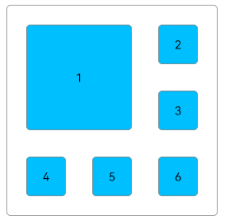
设置子组件的权重
代码如下:
@Override
protected void onStart(Intent intent) {
...
TableLayout.LayoutConfig tlc = new TableLayout.LayoutConfig(0, vp2px(48));
tlc.columnSpec = TableLayout.specification(TableLayout.DEFAULT, 1, 1.0f);
tlc.rowSpec = TableLayout.specification(TableLayout.DEFAULT, 1);
findComponentById(ResourceTable.Id_text_one).setLayoutConfig(tlc);
findComponentById(ResourceTable.Id_text_two).setLayoutConfig(tlc);
findComponentById(ResourceTable.Id_text_three).setLayoutConfig(tlc);
findComponentById(ResourceTable.Id_text_four).setLayoutConfig(tlc);
findComponentById(ResourceTable.Id_text_five).setLayoutConfig(tlc);
findComponentById(ResourceTable.Id_text_six).setLayoutConfig(tlc);
}上述代码将子组件的宽度权重设置为1.0,每行子组件会均分TableLayout的宽度,所以需要设置TableLayout为固定宽度或match_parent。
<TableLayout
ohos:width="match_parent"
...>
<Text
ohos:id="$+id:text_one"
.../>
<Text
ohos:id="$+id:text_two"
.../>
<Text
ohos:id="$+id:text_three"
.../>
<Text
ohos:id="$+id:text_four"
.../>
<Text
ohos:id="$+id:text_five"
.../>
<Text
ohos:id="$+id:text_six"
.../>
</TableLayout>图9 将子组件的宽度权重设置为1.0的效果展示